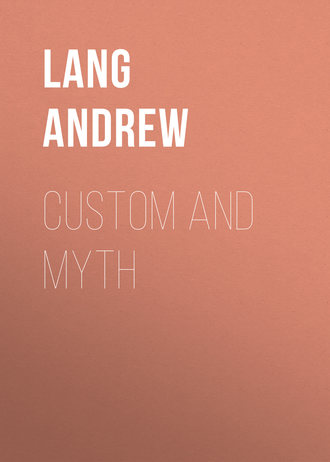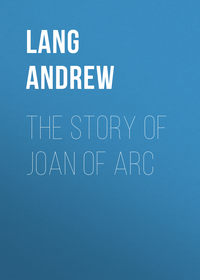 полная версия
полная версияCustom and Myth
Some learned men, Mr. Boyd Dawkins among them, believe that the Eskimo, that stunted hunting and fishing race of the Western Arctic circle, are descendants of the palæolithic sketchers, and retain their artistic qualities. Other inquirers, with Mr. Geikie and Dr. Wilson, do not believe in this pedigree of the Eskimo. I speak not with authority, but the submission of ignorance, and as one who has no right to an opinion about these deep matters of geology and ethnology. But to me, Mr. Geikie’s arguments appear distinctly the more convincing, and I cannot think it demonstrated that the Eskimo are descended from our old palæolithic artists. But if Mr. Boyd Dawkins is right, if the Eskimo derive their lineage from the artists of the Dordogne, then the Eskimo are sadly degenerated. In Mr. Dawkins’s ‘Early Man’ is an Eskimo drawing of a reindeer hunt, and a palæolithic sketch of a reindeer; these (by permission of the author and Messrs. Macmillan) we reproduce. Look at the vigour and life of the ancient drawing – the feathering hair on the deer’s breast, his head, his horns, the very grasses at his feet, are touched with the graver of a true artist. The design is like a hasty memorandum of Leech’s. Then compare the stiff formality of the modern Eskimo drawing. It is rather like a record, a piece of picture-writing, than a free sketch, a rapid representation of what is most characteristic in nature. Clearly, if the Eskimo come from palæolithic man, they are a degenerate race as far as art is concerned. Yet, as may be seen in Dr. Rink’s books, the Eskimo show considerable skill when they have become acquainted with European methods and models, and they have at any rate a greater natural gift for design than the Red Indians, of whose sacred art the Thunderbird brooding over page 298 is a fair example. The Red Men believe in big birds which produce thunder. Quahteaht, the Adam of Vancouver’s Island, married one, and this is she.
We have tried to show how savage decorative art supplied the first ideas of patterns which were developed in various ways by the decorative art of advancing civilisation. The same progress might be detected in representative art. Books, like the guide-book to ancient Greece which Pausanias wrote before the glory had quite departed, prove that the Greek temples were museums in which the development of art might be clearly traced. Furthest back in the series of images of gods came things like that large stone which was given to Cronus when he wished to swallow his infant child Zeus, and which he afterwards vomited up with his living progeny. This fetich-stone was preserved at Delphi. Next came wild bulks of beast-headed gods, like the horse-headed Demeter of Phigalia, and it seems possible enough that there was an Artemis with the head of a she-bear. Gradually the bestial characteristics dropped, and there appeared such rude anthropomorphic images of Apollo – more like South Sea idols than the archer prince – as are now preserved in Athens. Next we have the stage of semi-savage realism, which is represented by the metopes of Selinus in Sicily, now in the British Museum, and by not a few gems and pieces of gold work. Greek temples have fallen, and the statues of the gods exist only in scattered fragments. But in the representative collection of casts belonging to the Cambridge Archæological Museum, one may trace the career of Greek art backwards from Phidias to the rude idol.
‘Savage realism’ is the result of a desire to represent an object as it is known to be, and not as it appears. Thus Catlin, among the Red Indians, found that the people refused to be drawn in profile. They knew they had two eyes, and in profile they seemed only to have one. Look at the Selinus marbles, and you will observe that figures, of which the body is seen in profile, have the full face turned to the spectator. Again, the savage knows that an animal has two sides; both, he thinks, should be represented, but he cannot foreshorten, and he finds the profile view easiest to draw. To satisfy his need of realism he draws a beast’s head full-face, and gives to the one head two bodies drawn in profile. Examples of this are frequent in very archaic Greek gems and gold work, and Mr. A. S. Murray suggests (as I understand him) that the attitude of the two famous lions, which guarded vainly Agamemnon’s gate at Mycenæ, is derived from the archaic double-bodied and single-headed beast of savage realism. Very good examples of these oddities may be found in the ‘Journal of the Hellenic Society,’ 1881, pl. xv. Here are double-bodied and single headed birds, monsters, and sphinxes. We engrave three Greek gems from the islands as examples of savagery in early Greek art. In the oblong gem the archers are rather below the Red Indian standard of design. The hunter figured in the first gem is almost up to the Bushman mark. In his dress ethnologists will recognise an arrangement now common among the natives of New Caledonia. In the third gem the woman between two swans may be Leda, or she may represent Leto in Delos. Observe the amazing rudeness of the design, and note the modern waist and crinoline. The artists who engraved these gems on hard stone had, of necessity, much better tools than any savages possess, but their art was truly savage. To discover how Greek art climbed in a couple of centuries from this coarse and childish work to the grace of the Ægina marbles, and thence to the absolute freedom and perfect unapproachable beauty of the work of Phidias, is one of the most singular problems in the history of art. Greece learned something, no doubt, from her early knowledge of the arts the priests of Assyria and Egypt had elaborated in the valleys of the Euphrates and the Nile. That might account for a swift progress from savage to formal and hieratic art; but whence sprang the inspiration which led her so swiftly on to art that is perfectly free, natural, and god-like? It is a mystery of race, and of a divine gift. ‘The heavenly gods have given it to mortals.’
1
Compare De Cara: Essame Critico, xx. i.
2
Revue de l’Hist. des Rel. ii. 136.
3
Sprachvergleichung und Urgeschichte, p. 431.
4
Prim. Cult. i. 394.
5
A study of the contemporary stone age in Scotland will be found in Mitchell’s Past and Present.
6
About twenty years ago, the widow of an Irish farmer, in Derry, killed her deceased husband’s horse. When remonstrated with by her landlord, she said, ‘Would you have my man go about on foot in the next world?’ She was quite in the savage intellectual stage.
7
At the solemn festival suppers, ordained for the honour of the gods, they forget not to serve up certain dishes of young whelp’s flesh. (Pliny, H. N. xxix. 4.)
8
Nov. 1880.
9
‘Ah, once again may I plant the great fan on her corn-heap, while she stands smiling by, Demeter of the threshing floor, with sheaves and poppies in her hands’ (Theocritus, vii. 155-157).
10
Odyssey, xi. 32.
11
Rev. de l’Hist. des Rel., vol. ii.
12
Pausanias, iii. 15. When the boys were being cruelly scourged, the priestess of Artemis Orthia held an ancient barbaric wooden image of the goddess in her hands. If the boys were spared, the image grew heavy; the more they were tortured, the lighter grew the image. In Samoa the image (shark’s teeth) of the god Taema is consulted before battle. ‘If it felt heavy, that was a bad omen; if light, the sign was good’ – the god was pleased (Turner’s Samoa, p. 55).
13
Kamilaroi and Kurnai, p. 268.
14
Fison, Journal Anthrop. Soc., Nov. 1883.
15
Taylor’s New Zealand, p. 181.
16
This is not the view of le Père Lafitau, a learned Jesuit missionary in North America, who wrote (1724) a work on savage manners, compared with the manners of heathen antiquity. Lafitau, who was greatly struck with the resemblances between Greek and Iroquois or Carib initiations, takes Servius’s other explanation of the mystica vannus, ‘an osier vessel containing rural offerings of first fruits.’ This exactly answers, says Lafitau, to the Carib Matoutou, on which they offer sacred cassava cakes.
17
The Century Magazine, May 1883.
18
Κωνος ξυλαριον ου εξηπται το σπαρτιον και εν ταις τελεταις εδονειτο ινα ροιζη. Lobeck, Aglaophamus (i. p. 700).
19
De Corona, p. 313.
20
Savage Africa. Captain Smith, the lover of Pocahontas, mentions the custom in his work on Virginia, pp. 245-248.
21
Brough Smyth, i. 60, using evidence of Howitt, Taplin, Thomas, and Wilhelmi.
22
Kamilaroi and Kurnai, p. 214.
23
Περι ορχησεως, c. 15.
24
Cape Monthly Magazine, July 1874.
25
Wallace, Travels on the Amazon, p. 349.
26
New Zealand, Taylor, pp. 119-121. Die heilige Sage der Polynesier, Bastian, pp. 36-39.
27
A crowd of similar myths, in one of which a serpent severs Heaven and Earth, are printed in Turner’s Samoa.
28
The translation used is Jowett’s.
29
Theog., 166.
30
Apollodorus, i. 15.
31
Primitive Culture, i. 325.
32
Pauthier, Livres sacrés de l’Orient, p. 19.
33
Muir’s Sanskrit Texts, v. 23. Aitareya Brahmana.
34
Hesiod, Theog., 497.
35
Paus. x. 24.
36
Bleek, Bushman Folklore, pp. 6-8.
37
Theal, Kaffir Folklore, pp. 161-167.
38
Brough Smith, i. 432-433.
39
i. 338.
40
Rel. de la Nouvelle-France (1636), p. 114.
41
Codrington, in Journal Anthrop. Inst. Feb. 1881. There is a Breton Märchen of a land where people had to ‘bring the Dawn’ daily with carts and horses. A boy, whose sole property was a cock, sold it to the people of this country for a large sum, and now the cock brings the dawn, with a great saving of trouble and expense. The Märchen is a survival of the state of mind of the Solomon Islanders.
42
Selected Essays, i. 460.
43
Ibid. i. 311.
44
Ueber Entwicklungsstufen der Mythenbildung (1874), p. 148.
45
ii. 127.
46
G. D. M., ii. 127, 129.
47
Gr. My., i. 144.
48
De Abst., ii. 202, 197.
49
Rel. und Myth., ii. 3.
50
Ursprung der Myth., pp. 133, 135, 139, 149.
51
Contemporary Review, Sept. 1883.
52
Rev. de l’Hist. rel. i. 179.
53
That Pururavas is regarded as a mortal man, in relations with some sort of spiritual mistress, appears from the poem itself (v. 8, 9, 18). The human character of Pururavas also appears in R. V. i. 31, 4.
54
Selected Essays, i. 408.
55
The Apsaras is an ideally beautiful fairy woman, something ‘between the high gods and the lower grotesque beings,’ with ‘lotus eyes’ and other agreeable characteristics. A list of Apsaras known by name is given in Meyer’s Gandharven-Kentauren, p. 28. They are often regarded as cloud-maidens by mythologists.
56
Selected Essays, i. p. 405.
57
Cf. ruber, rufus, O. H. G. rôt, rudhira, ερυθρος; also Sanskrit, ravi, sun.
58
Myth. Ar. Nat., ii. 81.
59
R. V. iii. 29, 3.
60
The passage alluded to in Homer does not mean that dawn ‘ends’ the day, but ‘when the fair-tressed Dawn brought the full light of the third day’ (Od., v. 390).
61
Liebrecht (Zur Volkskunde, 241) is reminded by Pururavas (in Roth’s sense of der Brüller) of loud-thundering Zeus, εριyδουπος.
62
Herabkunft des Fetters, p. 86-89.
63
Liebrecht (Zur Volkskunde, p. 241) notices the reference to the ‘custom of women.’ But he thinks the clause a mere makeshift, introduced late to account for a prohibition of which the real meaning had been forgotten. The improbability of this view is indicated by the frequency of similar prohibitions in actual custom.
64
Astley, Collection of Voyages, ii. 24. This is given by Bluet and Moore on the evidence of one Job Ben Solomon, a native of Bunda in Futa. ‘Though Job had a daughter by his last wife, yet he never saw her without her veil, as having been married to her only two years.’ Excellently as this prohibition suits my theory, yet I confess I do not like Job’s security.
65
Brough Smyth, i. 423.
66
Bowen, Central Africa, p. 303.
67
Lafitau, i. 576.
68
Lubbock, Origin of Civilisation (1875), p. 75.
69
Chansons Pop. Bulg., p. 172.
70
Lectures on Language, Second Series, p. 41.
71
J. A. Farrer, Primitive Manners, p. 202, quoting Seemann.
72
Sébillot, Contes Pop. de la Haute-Bretagne, p. 183.
73
Gervase of Tilbury.
74
Kuhn, Herabkunft, p. 92.
75
Chips, ii. 251.
76
Kitchi Gami, p. 105.
77
The sun-frog occurs seven times in Sir G. W: Cox’s Mythology of the Aryan Peoples, and is used as an example to prove that animals in myth are usually the sun, like Bheki, ‘the sun-frog.’
78
Dalton’s Ethnol. of Bengal, pp. 165, 166.
79
Taylor, New Zealand, p. 143.
80
Liebrecht gives a Hindoo example, Zur Volkskunde, p. 239.
81
Cymmrodor, iv. pt. 2.
82
Prim. Cult., i. 140.
83
Primitive Manners, p. 256.
84
See Meyer, Gandharven-Kentauren, Benfey, Pantsch., i. 263.
85
Selected Essays, i. 411.
86
Callaway, p. 63.
87
Ibid., p. 119.
88
Primitive Culture, i. 357: ‘The savage sees individual stars as animate beings, or combines star-groups into living celestial creatures, or limbs of them, or objects connected with them.’
89
This formula occurs among Bushmen and Eskimo (Bleek and Rink).
90
The events of the flight are recorded correctly in the Gaelic variant ‘The Battle of the Birds.’ (Campbell, Tales of the West Highlands, vol. i. p. 25.)
91
Ralston, Russian Folk Tales, 132; Köhler, Orient und Occident, ii. 107, 114.
92
Ko ti ki, p. 36.
93
Callaway, pp. 51, 53, 64, 145, 228.
94
See also ‘Petrosinella’ in the Pentamerone, and ‘The Mastermaid’ in Dasent’s Tales from the Norse.
95
Folk-Lore Journal, August 1883.
96
Poetæ Minores Gr. ii.
97
Mythol. Ar., ii. 150.
98
Gr. My., ii. 318.
99
Sonne, Mond und Sterne, pp. 213, 229.
100
This proves that the tale belongs to the pre-Christian cannibal age.
101
Turner’s Samoa, p. 102. In this tale only the names of the daughters are translated; they mean ‘white fish’ and ‘dark fish.’
102
Folk-Lore Journal, August 1883.
103
Schoolcraft, Algic Researches, ii. 94-104.
104
Nature, March 14, 1884.
105
The earlier part of the Jason cycle is analysed in the author’s preface to Grimm’s Märchen (Bell & Sons).
106
Comm. Real. i. 75.
107
See Early History of the Family, infra.
108
The names Totem and Totemism have been in use at least since 1792, among writers on the North American tribes. Prof. Max Müller (Academy, Jan. 1884) says the word should be, not Totem, but Ote or Otem. Long, an interpreter among the Indians, introduced the word Totamism in 1792.
109
Christoval de Moluna (1570), p. 5.
110
Cieza de Leon, p. 183.
111
Idyll xv.
112
Sayce, Herodotos, p. 344; Herodotus, ii. 42; Wilkinson’s Ancient Egyptians (1878, ii. 475, note 2); Plutarch, De Is. et Os., 71, 72; Athenæus, vii. 299; Strabo, xvii. 813.
113
The Mouse, according to Dalton, is still a totem among the Oraons of Bengal. A man of the Mouse ‘motherhood,’ as the totem kindred is locally styled, may not eat mice (esteemed a delicacy), nor marry a girl who is a Mouse.
114
xiii. 604. Casaub. 1620.
115
There were Sminthiac feasts at Rhodes, Gela, Lesbos, and Crete (De Witte, Revue Numismatique, N.S. iii. 3-11).
116
Iliad, i. 39.
117
Ælian, H. A. xii. 5.
118
The bas-relief is published in Paoli’s Della Religione de’ Gentili, Naples, 1771, p. 9; also by Fabretti, Ad Cal. Oper. de Colum. Trajan. p. 315. Paoli’s book was written after the discovery in Neapolitan territory of a small bronze image, hieratic in character, representing a man with a mouse on his hand. Paoli’s engraving of this work of art, unluckily, does not enable us to determine its date or provenance. The book is a mine of mouse-lore.
119
Colden, History of the Five Nations, p. 15 (1727).
120
Onomast., ix. 6, segm. 84, p. 1066.
121
De Witte says Pollux was mistaken here. In the Revue Numismatique, N.S. iii., De Witte publishes coins of Alexandria, the more ancient Hamaxitus, in the Troad. The Sminthian Apollo is represented with his bow, and the mouse on his hand. Other coins show the god with the mouse at his foot, or show us the lyre of Apollo supported by mice. A bronze coin in the British Museum gives Apollo with the mouse beside his foot.
122
Spanheim, ad Fl. Joseph., vi. I, p. 312.
123
Della Rel., p. 174.
124
Herodotus, ii. 141.
125
Liebrecht (Zur Volkskunde, p. 13, quoting Journal Asiatique, 1st series, 3, 307) finds the same myth in Chinese annals. It is not a god, however, but the king of the rats, who appears to the distressed monarch in his dream. Rats then gnaw the bowstrings of his enemies. The invaders were Turks, the rescued prince a king of Khotan. The king raised a temple, and offered sacrifice – to the rats?
126
Herodotos, p. 204.
127
Wilkinson, iii. 294, quoting the Ritual xxxiii.: ‘Thou devourest the abominable rat of Ra, or the sun.’
128
Mr. Loftie has kindly shown me a green mouse containing the throne-name of Thothmes III. The animals thus used as substitutes for scarabs were also sacred, as the fish, rhinoceros, fly, all represented in Mr. Loftie’s collection. See his Essay of Scarabs, p. 27. It may be admitted that, in a country where Cats were gods, the religion of the Mouse must have been struggling and oppressed.
129
Strabo, xiii. 604.
130
Eustathius on Iliad, i. 39.
131
A Strange and True Relation of the Prodigious Multitude of Mice, 1670.
132
Journal of Philol., xvii. p. 96.
133
Leviticus xi. 29.
134
Samuel i. 5, 6.
135
Zool. Myth, ii. 68.
136
Mélusine, N.S. i.
137
De Iside et Osiride, lxxvi.
138
This hypothesis does not maintain that totemism prevailed in Greece during historic times. Though Plutarch mentions an Athenian yενος, the Ioxidæ, which claimed descent from and revered asparagus, it is probable that genuine totemism had died out of Greece many hundreds of years before even Homer’s time. But this view is not inconsistent with the existence of survivals in religion and ritual.
139
Rolland, Faune populaire.
140
The attempt is not to explain the origin of each separate name but only of the general habit of giving animal or human names stars.
141
Mr. Herbert Spencer believes that the Australians were once more civilised than at present. But there has never been found a trace of pottery on the Australian continent, which says little for their civilisation in the past.
142
Brugsch, History of Egypt, i. 32.
143
Brough Smith.
144
Amazonian Tortoise Myths, p. 39.
145
Sahagun, vii. 3.











